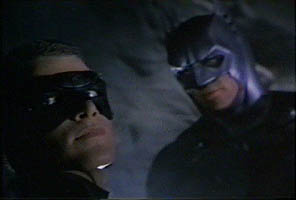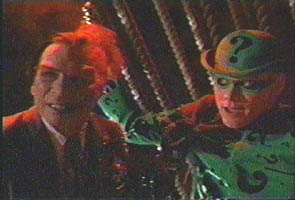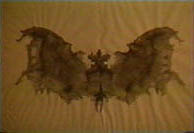|
Sounding like a Greatest Hits collection put out by a soon-to-be-sued band called "Batman," Batman Forever was the film that introduced a new director, a new approach to the Batman franchise, and of course Robin, even though it was the fourth film that ended up being called Batman and Robin, which was the film introducing Batgirl. Yes, I know it doesn't make any sense. It's the least of the problems here. Apparently, audiences found Batman Returns too dark for their general tastes. I found it a vast improvement upon the first Batman film, but as nobody listens to me, those actually in charge decided to go for a lighter tone and be done with the gothic ghoulishness of Tim Burton's version. Michael Keaton also departed after expressing dissatisfaction with the "family-friendly" approach, and when it was all over, there was little besides the recurring parts of Alfred and the criminally underutilised Commissioner Gordon to give any indication that there was meant to be some connective tissue with the two previous films. 
Continuing the structure of Batman Returns, Forever once more provides two villains. While Returns had benefited from this approach, given that Catwoman wasn't a fully-fledged villain and was doubling as the romantic interest, this film could've done well to have stuck with one. Both of the new bad guys, Two-Face and The Riddler, could have alone provided enough menace to give our hero a run for his money. With Two-Face, you have a psychologically and physically scarred man who was once a hero and has now gone off the deep end, obsessed by the notion that the luck of the toss is the only true justice in the world. With The Riddler, you have a criminal mastermind who likes to play mind games and is so assured of his own cleverness that he leaves tantalizing clues regarding his plans for Batman to decode, daring his adversary to outthink him. Fortunately, most of these character traits were sheared out of future Oscar winner(?) Akiva Goldsman's script, so there was plenty of room for both baddies after all! Oh, wait, that's the bad part. Early in the film, Batman meets Dr. Chase Meridian (who was apparently a KISS groupie in her younger years, judging by her behavior), a psychologist brought in to try and predict Two-Face's actions, given his wacky "multiple personality disorder." Adding a psychological component to a Batman film is a good idea in theory, but if I'm going to see someone trying to pick apart Bruce/Batman's mind, I want it to be the Riddler, not yet another love interest who we know will not outlast this movie. Sadly, the Riddler, starting off as an employee of Wayne Enterprises who wants revenge after Bruce shoots down his VR brain siphoning gadget, simply winds up running about acting loud and manic, occasionally leaving mindlessly simplistic riddles for Bruce to find and solve in three seconds (which eventually add up into one big riddle so convoluted that only the screenwriter could see how it could make sense) instead of showing any real genius. Not helping the formula is that Two-Face is essentially the same damned villain. The film pretends to deal with dual natures, even in its iconography (such as the half-black, half-white dream totem Chase shows to Bruce), but again, it's only good in theory. The Two-Face of this film has no duality, no split personality. Allow me to dissect the entirety of the character's psychological divide: "I rant maniacally about killing Batman"/"I speak in a calm and dignified manner...about killing Batman." There it is. The only internal conflict in this guy is a question of volume. What's he got against Batman? He irrationally blames him for the fact that a mob boss scarred his face with acid in open court, a sentiment only slightly less confusing than the issue of why Batman was apparently hiding inside the jury box. I haven't even gotten to Robin yet, who appeared in the trailer delivering the pointed soundbite "I'm a part of this whether you like it or not," perhaps the most obvious bit of bird-flipping at potential naysayers I've ever seen in an ad. 
Dick Grayson, a man clearly in his early twenties, ends up becoming Bruce Wayne's ward after his family of circus performers is killed by Two-Face. It doesn't take long for Dick to suss out what's really up at Wayne Manor, and he demands to be let in on the action. It's only fair; he just wants the same thing the orphaned Bruce did. Bruce sees himself in the younger man's desire for revenge, and worries over whether or not Batman is a good thing after all. Somewhere in there, there's a good story screaming to be let out, but the film's attempts at even semi-serious themes are undercut by the complete cartoonishness of the villains; when the bad guys pair up, it's like watching a marathon of "Ren and Stimpy Get X-ed out and Go to a Rave," which is only helped by the color scheme and whirling lights. Why do Tommy gun clips come with neon swirls, you might ask early on? "Oh," you later realize, "because everything else does." The film is as unconcerned with logic as were its predecessors. For the final confrontation, Bruce breaks out a new batsuit with a new sonar gadget. "But it hasn't been tested yet!" protests Alfred. Of course it hasn't. These things never are in films, and it never matters. Is a malfunctioning sonar device going to blow off Batman's head? No? Then who cares? Why does he need this sonar gizmo? So he can throw a Batarag at the huge machine in the middle of the otherwise mostly empty room, which he apparently couldn't have seen with his own eyes. And if, as he claims, the Riddler grows smarter with every brain drained, why is he so stupid as to not even think of, oh, say, putting a fence around his precious machine, knowing that it's so fragile that a hand-tossed object will bust it into a billion pieces? And frankly, it doesn't speak well of Batman's status as the "world's greatest detective" when he can't deduce the Riddler's identity, even though his first two riddles come with a photo of his unmasked face. 
This film is strangely entertaining in a way, but one that has nothing to do with intelligence. It's repeatedly frustrating in the fact that it keeps claiming to do interesting things instead of actually doing them. Commenting on a picture in Chase's office, Bruce is told that perhaps he "has a thing for bats," because the picture he's observing is actually an ink blot. Yes, it is. Of a BAT. Sometimes, there's no depth to see, no matter how hard you might try. -review by Matt Murray
|
|
||||||||